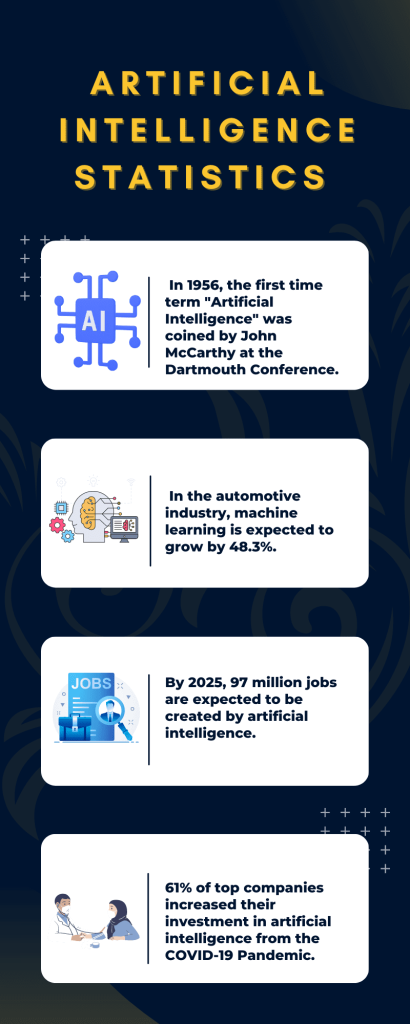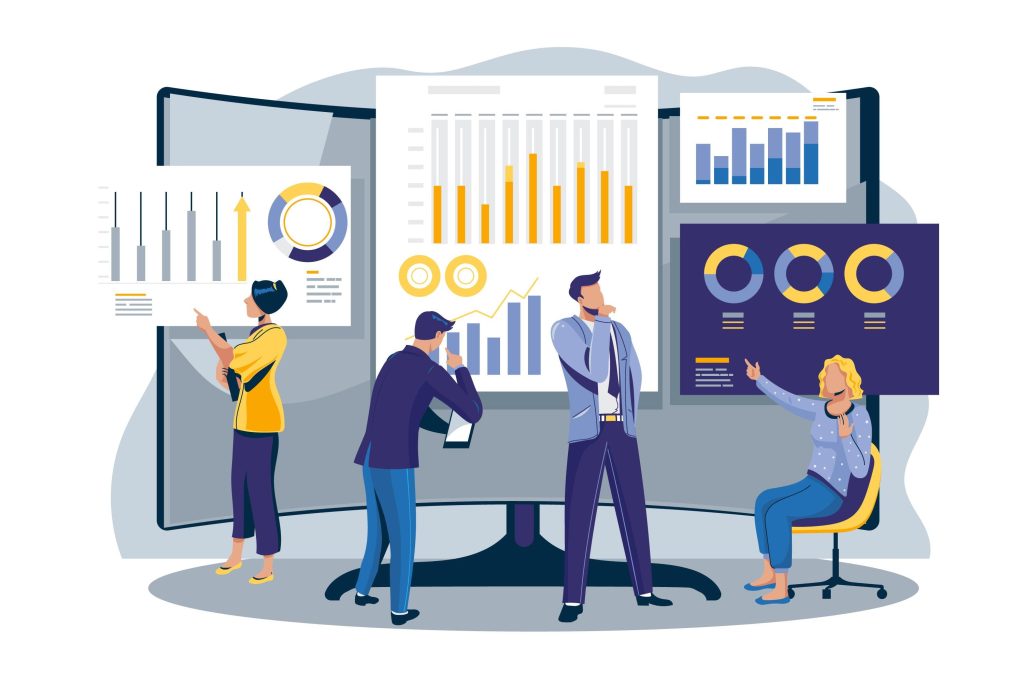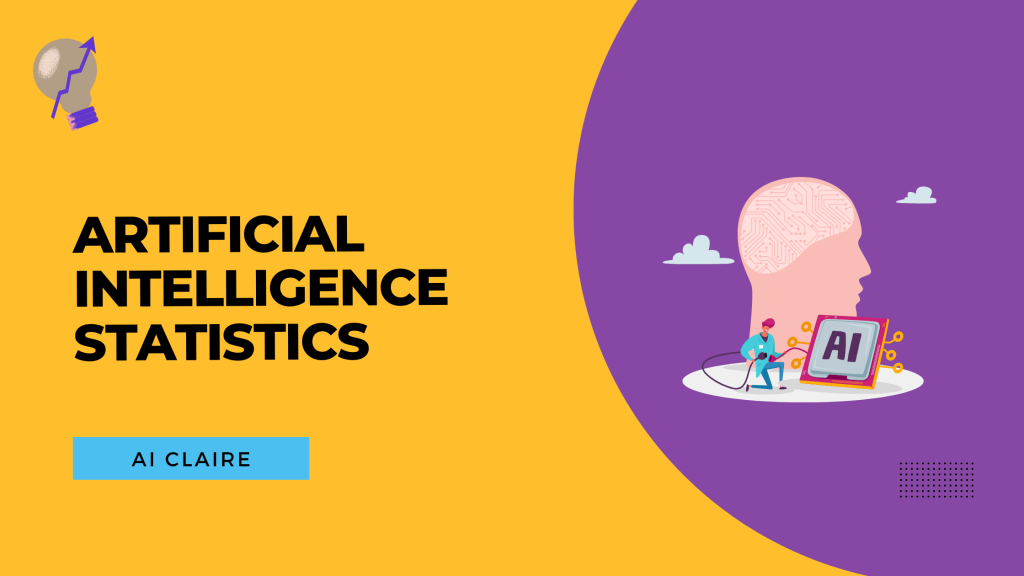Artificial intelligence is like that super intelligent friend you always have who knows all the answers, but instead of a pocket calculator, they have a supercomputer for a brain.
The science fiction stuff of our childhood dreams comes to life! But hold on, before we get too excited and let the robots take over, let’s explore this exciting world of artificial intelligence and see what it can do, from cracking jokes to saving the world.
So sit back, relax, and get ready for some robot-tastic fun.
Artificial Intelligence Statistics (2025 Top Pick)

- In 1956, the first time term “Artificial Intelligence” was coined by John McCarthy at the Dartmouth Conference.
- Google Assistant in the navigation category ranks first among all voice assistants with 98% of accuracy.
- ChatGPT received 1 million users just five days after its launch.
- ChatGPT launched its pricing plan on 21st January 2023. They will charge $42 per month for a professional plan.
- In the automotive industry, machine learning is expected to grow by 48.3%.
- Over 48% of businesses use machine learning or artificial intelligence.
- The artificial intelligence market is projected to reach $1.81 billion in 2030.
- The artificial intelligence market CAGR is expected to grow at 38.1% from 2022 to 2030.
- By 2025, 97 million jobs are expected to be created by artificial intelligence.
- 16% of U.S. jobs can be replaced by artificial intelligence by 2025.
- The Energy (Coal, Oil, etc.) sector will reduce 16.5% of emissions by using artificial intelligence.
- 83% of companies said their top priority is using artificial intelligence in their business strategy.
- For 40% more market revenue, the marketing and sales department prioritizes artificial intelligence and machine learning.
- 61% of top companies increased their investment in artificial intelligence from the COVID-19 Pandemic.
- 4% of businesses are not ready to adopt artificial intelligence due to security reasons.
Early Development of Artificial Intelligence
Artificial Intelligence has come a long way since its inception in the 1950s. Initially, the focus of artificial intelligence research was on creating machines that could perform tasks that normally require human intelligence, such as problem-solving, decision-making, and language understanding.

Over the years, significant advances have been made in artificial intelligence, resulting in the development of numerous applications in a wide range of fields, including medicine, finance, and manufacturing.
In this first section of the article, we will see some interesting facts about AI apart from the Statistics.
- In 1956, the first time term “Artificial Intelligence” was coined by John McCarthy at the Dartmouth Conference.
- From 1956 to 1974, the field of Artificial Intelligence research was founded at a conference held at Dartmouth College, with the participation of computer scientists, mathematicians, and engineers who aimed to create machines that could ‘think’ and ‘learn’ like humans.
- In 1996, the first artificial intelligence language, LISP, was created by John McCarthy.
- In 1971, the first expert system, MYCIN, was developed for diagnosing infectious blood diseases.
- In 1980, the first artificial intelligence stock market predictions were made using linear regression analysis.
- In 1997, the first artificial intelligence over a human in a chess game occurred when IBM’s Deep Blue defeated Garry Kasparov.
- In 2011, IBM’s Watson won Jeopardy! And became the first artificial intelligence system to beat human champions in a complex and demanding game.
- In 2022, OpenAI developed the chatbot chatGPT, which is a concern for many. We will discuss ChatGPT in the next section of the article in more detail.
Source: Livescience, Javatpoint.
General Artificial Intelligence Statistics
- Google Assistant in the navigation category ranks first among all voice assistants with 98% of accuracy.
Here is a table showing the accuracy of Google Assistance, Alexa, and Siri by category.
| Category | Alexa | Google Assistant | Siri |
| Local | 85% | 93% | 89% |
| Commerce | 71% | 92% | 68% |
| Navigation | 72% | 98% | 86% |
| Information | 93% | 96% | 76% |
| Command | 69% | 86% | 93% |
- 72% of people use voice assistance.
- 80% of people interacted with chatbots at any point.
- $8.9 billion revenue of artificial intelligence comes from vehicular detection and avoidance.
Here is a table showing the global artificial intelligence revenue breakdown.
| Sectors | Revenue |
| Vehicular detection and avoidance | 8.9 billion |
| Static image recognition | 7.6 billion |
| Processing of patient data | 7.2 billion |
| Algorithmic trading strategy | 6.4 billion |
| Localization and mapping | 6.0 billion |
| Predictive maintenance | 5.7 billion |
| Cyber security and threat prevention | 5.4 billion |
| Paperwork to digital data conversion | 5.4 billion |
| Intelligent HR systems | 5.3 billion |
| Medical image analysis | 5.1 billion |
Source: Explodingtopics, Finance Online, Answeriq
ChatGPT statistics
ChatGPT is a cutting-edge language model developed by OpenAI.
As one of the largest language models to date, ChatGPT represents a major step forward in the development of artificial development and its potential applications.
Today, everyone is talking about ChatGPT everywhere. But why is ChatGPT trending nowadays? To know this, go through this section.
In this section, we have gathered all our top research about ChatGPT.

- ChatGPT received 1 million users just five days after its launch.
Here is a table showing the top 5 platforms which received 1 million users in a minimum day.
| Rank | Platform | Received 1 million users in a minimum of days |
| 1. | ChatGPT | 5 days |
| 2. | 10 days | |
| 3. | 60 days | |
| 4. | Spotify | 150 days |
| 5. | Netflix | 1245 days |
- The revenue of ChatGPT is projected to reach $200 million at the end of 2023.
- ChatGPT launched its pricing plan on 21st January 2023. They will charge $42 per month for a professional plan.
- $100,000 per day is the running cost of ChatG.
- Microsoft invested $1 billion in ChatGPT.
- Over 500 million people used ChatGPT as of 2023.
- ChatGPT has 96,000,000 visitors monthly.
- On a basis, ChatGPT receives 10 million queries.
- In the ChatGPT system, 3000 words were added.
- ChatGPT’s accuracy rate is almost 90%.
While CHatGPT is trending all over the world, there are also some countries that have banned ChatGPT due to security reasons.
Here is a table showing the countries where ChatGPT is banned.
| Sr. No. | Country |
| 1. | Russia |
| 2. | China |
| 3. | Iran |
| 4. | Ukraine |
| 5. | Venezuela |
| 6. | Belarus |
| 7. | Afghanistan |
Source: Answeriq.
Machine Learning and Artificial Intelligence Statistics
Machine learning (ML) and Artificial Intelligence (AI) are transforming the way we live and work. They are the driving forces behind some of the most cutting-edge technologies.
Machine learning is the subfield of artificial intelligence that enables computers to learn and make predictions based on data without being explicitly programmed.
In this section, we will delve into the world of ML and AI, exploring how they work and their impact on industries.

- In the automotive industry, machine learning is expected to grow by 48.3%.
- The Machine learning program of Google is 89% accurate.
- Netflix saved $1 billion by using machine learning.
- 20% of C-level executives use machine learning.
- 300 million emails are sent every day, and out of that, 50% of emails are detected as spam by machine learning.
- Over 48% of businesses use machine learning or artificial intelligence.
Source: Answeriq, PWC, Accenture, Exploding topics, Financeonline
Artificial Intelligence Market Size Statistics
The artificial intelligence market is one of the fastest-growing industries in the world and is expected to continue its rapid expansion in the coming years.
With the increasing demand for intelligent technologies in various industries, from healthcare and finance to retail and transportation, the artificial intelligence market size is expected to reach new heights.
In this section, we will see some important statistics on the artificial intelligence market size.
- The artificial intelligence market is projected to reach $1.81 billion in 2030.
- The artificial intelligence market CAGR is expected to grow at 38.1% from 2022 to 2030.
- The U.S. artificial intelligence market is expected to reach $223.45 billion in 2029.
- U.S. artificial intelligence market CAGR is expected to grow at 42.15% from 2020 to 2029.
- The revenue of the artificial intelligence software market is $70.94 billion as of 2023.
Here is a table showing the revenue of the global artificial intelligence software market from 2018 to 2025.
| Year | Revenue |
| 2018 | $10.10 billion |
| 2019 | $14.690 billion |
| 2020 | $22.580 billion |
| 2021 | $34.870 billion |
| 2022 | $51.270 billion |
| 2023 | $70.940 billion |
| 2024* | $94.410 billion |
| 2025* | $1260 billion |
*Forecast
- In the artificial intelligence software market, the North American region contributed the most to other regions, with 51.58 billion as of 2023.
Here is a table showing the market share of the North American region in the global artificial intelligence software market from 2018 to 2025.
| Year | North America revenue |
| 2018 | 4.11 billion |
| 2019 | 6.36 billion |
| 2020 | 9.8 billion |
| 2021 | 15.08 billion |
| 2022 | 22.23 billion |
| 2023 | 30.9 billion |
| 2024* | 41.06 billion |
| 2025* | 51.58 billion |
*Forecast
- The growth of the artificial intelligence software market is 38% as of 2023.
Here is a table showing the growth of the artificial intelligence software market from 2019 to 2025.
| Year | Growth |
| 2019 | 54% |
| 2020 | 54% |
| 2021 | 54% |
| 2022 | 47% |
| 2023 | 38% |
| 2024 | 33% |
| 2025 | 26% |
- Artificial intelligence is expected to add $1 billion to the banking industry revenue by 2035.
- Artificial intelligence’s use in the telecommunication industry will cost $2.5 billion in 2022.
- Artificial intelligence’s use in the telecommunication industry is expected to grow at a CAGR of 46.8% from 2016 to the end of 2023.
Source: GrandViewResearch, Answeriq, Markets and Markets,
How Artificial Intelligence Impacts the Workforce Statistics
Artificial intelligence is having a profound impact on the modern workforce. It has the potential to automate repetitive tasks, increase efficiency, and improve decision-making processes.
However, there is also concern about the displacement of jobs and the need for workers to reskill in order to remain relevant in a rapidly changing job market.
In this section, we have gathered all the important information about how artificial intelligence impacts workforce statistics.
- By 2025, 97 million jobs are expected to be created by artificial intelligence.
- By 2025, 85 million jobs will be displaced by artificial intelligence.
- Half of the global workforce needs to be reskilled by 2030.
- 16% of U.S. jobs can be replaced by artificial intelligence by 2025.
- Robots can take over 20 million jobs in 2030.
- Robots can do 70% of the task in the U.S. by 2030.
Here is a table showing the top 10 jobs that are most at risk of Automation.
| Rank | Jobs that are most at the risk of automation | Percentage |
| 1. | Food preparation and Service | 81% |
| 2. | Production Operations | 79% |
| 3. | Office and administrative support | 69% |
| 4. | Farming, fishing, and forestry | 56% |
| 5. | Transportation and material moving | 55% |
| 6. | Construction and extraction | 50% |
| 7. | Installations, maintenance, and repair | 49% |
| 8. | Sales | 43% |
| 9. | Healthcare support | 40% |
| 10. | Legal | 38% |
- 38% of employees think that their job will be automated by the end of 2023.
- 13% of employees expect that artificial intelligence will eliminate positions entirely in their industry.
- 97 million artificial intelligence specialists will be needed by 2025.
Source: Answeriq, World Economic Forum, Finance Online
Artificial Intelligence and Climate Change Statistics
AI is increasingly being recognized as a tool in the fight against climate change. By analyzing vast amounts of data and automating complex processes.
AI can help reduce the greenhouse effect, improve energy efficiency, and support the development of renewable energy sources.
In this section, we will see important statistics on artificial intelligence and climate change.
- The Energy (Coal, Oil, etc.) sector will reduce 16.5% of emissions by using artificial intelligence.
Here is a table showing the top 6 sectors by average emission reduction.
| Rank | Sector | Average Emission Reduction |
| 1. | Medical devices | 18.3% |
| 2. | Energy (Coal, Oil, etc) | 16.5% |
| 3. | Utilities (Water, Gas, Electricity, etc) | 15.9% |
| 4. | Consumer Products | 15.5% |
| 5. | Automotive | 15.2% |
| 6. | Retail | 15% |
| 7. | Others | 17.6% |
| 8. | Global | 15.9% |
- The Automotive industry will contribute 22% in economic emission intensity (EEI) from artificial intelligence by 2030.
Here is a table showing some industries that will contribute to economic emission intensity from Artificial intelligence by 2030.
| Industry | Artificial intelligence’s contribution in economic emission intensity reduction |
| Consumer Retail | 45% |
| Utilities | 32% |
| Automotive | 22% |
| Oil and Gas | 18% |
| Wholesale Retail | 11% |
Source: Demandsage,
Artificial Intelligence in Businesses Statistics
Artificial intelligence is rapidly transforming the business landscape by automating routine tasks, improving decision-making, and enhancing customer experiences.
AI-powered solutions are being implemented in a variety of industries and businesses to help them to increase efficiency, reduce costs, and stay competitive.

In this section, we have gathered all our top research about artificial intelligence in business statistics.
- 83% of companies said their top priority is using artificial intelligence in their business strategy.
Here is a table showing the current usage of Artificial Intelligence in companies.
| Artificial intelligence current usage | Share of respondents |
| We don’t use artificial intelligence but we are looking to implement it | 7.0% |
| We have applied a few proofs of concepts with limited success | 14.0% |
| We have a few challenging proofs of concepts and are looking forward to scale it | 21.0% |
| We have process that are fully supported by artificial intelligence with widespread adoption | 25.0% |
| We have using with limited artificial intelligence use cases | 33.0% |
- 80% of retail experts expect to adopt artificial intelligence automation to their businesses by 2025.
- 17 of 20 CEOs said artificial intelligence would be the mainstream technology for their company.
- Artificial intelligence can improve employees by 40% of productivity by the end of 2035.
- Over half of telecommunication organizations (52%) use chatbots.
- The manufacturing industry is expected to gain a Gross Value Added (GVA) of 3.78 trillion from artificial intelligence by 2035.
Here is a table showing the expected gain of artificial intelligence’s Gross Value Added (GVA) in industries by 2035.
| Industry | Gross value added by Artificial intelligence | Base value |
| Accommodation and food services | $489.0 billion | $1.50 trillion |
| Fishing, Agriculture, and Forestry | $215.0 billion | $554.0 billion |
| Entertainment, Arts, and Recreation | $87.0 billion | $453.0 billion |
| Construction | $520.0 billion | $2.76.0 trillion |
| Education | $109.0 billion | $1.060 trillion |
| Financial Services | $1.150 trillion | 3.420 trillion |
| Healthcare | $461.0 billion | $2.260 trillion |
| Communication And Information | $951.0 billion | $3.720 trillion |
| Manufacturing | $3.780 trillion | $8.40 trillion |
| Other Services | $95.0 billion | $535.0 billion |
| Professional Services | $1.85 trillion | $7.470 trillion |
| Public Services | $939.0 billion | $3.990 trillion |
| Social Services | $216.0 billion | $1.080 trillion |
| Storage and Transportation | $744.0 billion | $2.130 trillion |
| Utilities | $304.0 billion | $962.0 billion |
| Wholesale and Retail | $2.230 trillion | $6.160 trillion |
- The global revenue of artificial intelligence self-driving vehicles is $173 billion as of 2023.
- Only 7% of people trust chatbots at the time of claim. 49%of people trust human advisors..
- Manufacturing organizations that use artificial intelligence perform 12% better than manufacturing organization that doesn’t use artificial intelligence.
- By 2025, 19 out of 20 customer interactions will be assisted by artificial intelligence.
- 52% of business professionals said artificial intelligence tools had increased their productivity.
- 50% of businesses said after using artificial intelligence, they had met their cost-saving goals.
- 54% of business executives agreed that by using artificial intelligence, they had improved their decision-making process.
- 67% of U.S.-based businesses said using artificial intelligence has improved their customer experience.
- 39% of top organizations have planned to invest in AI (Artificial Intelligence) or ML (Machine Learning) tools.
Source: Answeriq, PWC, Accenture, Exploding topics, Financeonline
Artificial Intelligence in Marketing, Sales, Customer Services Statistics
AI is revolutionizing the way businesses approach marketing, sales, and customer service. By leveraging machine learning algorithms and big data, AI-powered solutions can personalize marketing campaigns, improve lead generation, and enhance customer experience.

AI is also helping companies better understand their customers and make data-driven decisions.
In this section, we have compiled all our top research about Artificial intelligence in marketing, sales, and customer services statistics.
- For 40% more market revenue, the marketing and sales department prioritizes artificial intelligence and machine learning.
- Artificial intelligence algorithms can increase leads by more than 50%.
Here is a table showing some interesting research about artificial intelligence for sales.
| Artificial intelligence for Sales | Increased percentage |
| Leads | 50% |
| Reduced call time | 60% |
| Results in overall cost reduction | 60% |
- More than 41% of marketers said using artificial intelligence for email marketing increases market revenue.
Here is a table showing four positive effects of artificial intelligence in Email marketing.
| Positive effects of artificial intelligence | Share of respondents |
| Improvement in revenue | 41.29% |
| Improvement in click-through rate | 13.44% |
| Improvement in open rates | 7.64% |
| Improvement In deliverability | 1.13% |
- The adoption of artificial intelligence in sales is expected to grow by 155%.
- 28% of top companies used artificial intelligence for marketing.
- 29% of big organizations use artificial intelligence for driving campaigns and for better customer experience.
Source: Answeriq, Explodingtopics, Financeonline,
COVID-19 Pandemic and Artificial Intelligence Statistics
The COVID-19 pandemic has brought into sharp focus the critical role artificial intelligence can play in managing and responding to global health crises.
From tracking the spread of the virus to predicting future outbreaks and identifying high-risk populations, AI is providing valuable insights to help healthcare systems better respond to the pandemic.
In this section, we will see some essential statistics about the COVID-19 pandemic and artificial intelligence.

- 61% of top companies increased their investment in artificial intelligence from the COVID-19 Pandemic.
- 44% of Pharmaceutical companies, Healthcare systems and services have increased their investment in artificial intelligence during the COVID-19 Pandemic.
- 28% of financial services have increased their investment in artificial intelligence during the Pandemic.
Here is a table showing the average increase in artificial intelligence investment across business functions due toCOVID-19 Pandemic.
| Industry | Average increased in AI investment |
| Healthcare systems and services/ Pharma and medical products | 44% |
| Automotive and assembly | 42% |
| Financial Services | 28% |
| Consumer and packaged goods/retail | 26% |
| Business, legal, and professional services | 25% |
| High tech/ Telecom | 24% |
- 16% of European countries used artificial intelligence to reduce the impact of the COVID-19 pandemic.
- Artificial Intelligence was used in the mathematical models that study the transmission rate of COVID-19.
Source: Finance Online, Semrush,
Challenges in Artificial Intelligence Statistics
Despite the many benefits of artificial intelligence, it presents a number of challenges that need to be addressed in order to ensure its safe, ethical, and responsible deployment.
These challenges include issues related to data privacy, security, fairness, and bias in AI systems.
In this section, we will see the statistics of challenges in artificial intelligence.
- 4% of businesses are not ready to adopt artificial intelligence due to security reasons.
- 47% of organizations said an inadequate budget for artificial intelligence is a major concern to them.
- 23% of companies don’t need artificial intelligence.
- 76% of CEOs are concerned about transparency in the artificial intelligence market.
- 40% of executives think that artificial intelligence is expensive technology.
Source: Finance Online
Conclusion: Artificial Intelligence Statistics (2023)
Artificial intelligence statistics are crucial in understanding this field’s current state and future trajectory.
The market size of artificial intelligence software is growing rapidly. This market is growing at a very high CAGR.
Artificial intelligence is very useful in every sector, from medicine to climate change. It saves time, cost, etc., for everyone.
Despite having many benefits, artificial intelligence also has many challenges. Many organizations don’t feel safe with artificial intelligence due to security reasons.
Artificial intelligence statistics are changing every day, and we will be updating you with more recent statistics on artificial intelligence in this article.
Related Links
- Machine Learning vs AI: Differences, Applications & Benefits
- 10 Best AI Sales Software For Marketers
- 8+ Best AI Marketing Tools For Your Business
FAQs
72% of people are using voice assistants such as Google Assistance, Alexa, Siri, Cortana, etc. According to our research, Google assistance is more accurate than the others in every category.
80% of people interacted with chatbots at any point in their life. People like to interact with chatbots more than humans. The Gen Z population of the U.S. consider themself introverts, and they highly interact with chatbots.
In the U.S., there were 1400 autonomous cars in 2018. According to Statista, there are 48.59 million autonomous cars in the world.

